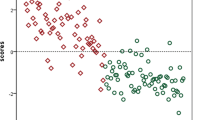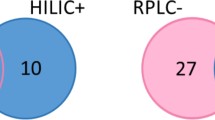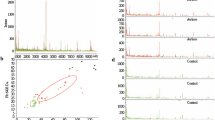Abstract
Autism Spectrum Disorder (ASD) is a neurodevelopmental disorder that affects approximately 1/68 children, with a more recent study suggesting numbers as high as 1/36. According to Diagnostic and Statistical Manual of Mental Disorders, the etiology of ASD is unknown and diagnosis of this disorder is behavioral. There is currently no biomarker signature for ASD, however, identifying a biomarker signature is crucial as it would aid in diagnosis, identifying treatment targets, monitoring treatments, and identifying the etiology of the disorder. Here we used nanoliquid chromatography-tandem mass spectrometry (nanoLC-MS/MS) to investigate the saliva from individuals with ASD and matched controls in a 14 vs 14 study. We found numerous proteins to have statistically significant dysregulations, including lactotransferrin, transferrin, polymeric immunoglobulin receptor, Ig A L, Ig J chain, mucin 5 AC, and lipocalin 1 isoform X1. These findings are consistent with previous studies by our lab, and others, and point to dysregulations in the immune system, lipid metabolism and/or transport, and gastrointestinal disturbances, which are common and reoccurring topics in ASD research.




Similar content being viewed by others
Data Availability
The mass spectrometry raw data are available upon request.
Abbreviations
- ASD:
-
Autism spectrum disorder
- DSM:
-
Diagnostic and statistical manual of mental disorders
- ADOS:
-
Autism diagnostic observation schedule
- LC:
-
Liquid chromatography
- MS:
-
Mass spectrometry
- CDC:
-
Center for disease control
- RT:
-
Room temperature
- HPLC:
-
High performance liquid chromatography
- DTT:
-
Dithiothreitol
- IAA:
-
Iodoacetamide
- UPLC:
-
Ultra-performance liquid chromatography
- ACN:
-
Acetonitrile
- FA:
-
Formic acid
References
Association AP (2013) Diagnostic and statistical manual of mental disorders (DSM-5®). American Psychiatric Pub, Washington
Christensen DL, Baio J, Braun KV et al (2016) Prevalence and characteristics of autism spectrum disorder among children aged 8 Years — autism and developmental disabilities monitoring Network, 11 Sites, United States, 2012. MMWR Surveill Summ. https://doi.org/10.15585/mmwr.ss6503a1
Maenner MJ, Warren Z, Williams AR, Amoakohene E, Bakian AV, Bilder D, A.,et al. (2023) Prevalence and characteristics of autism spectrum disorder among children aged 8 years - autism and developmental disabilities monitoring network, 11 Sites, United States, 2020. MMWR Surveill Summ 72(2):1–14. https://doi.org/10.15585/mmwr.ss7202a1
Costanzo V, Chericoni N, Amendola FA, Casula L, Muratori F, Scattoni ML, Apicella F (2015) Early detection of autism spectrum disorders: From retrospective home video studies to prospective ‘high risk’ sibling studies. Neurosci Biobehav Rev 55:627–635. https://doi.org/10.1016/j.neubiorev.2015.06.006
Schalkwyk V, Gerrit I, Peluso F, Qayyum Z, McPartland JC, Fred R (2015) Varieties of misdiagnosis in ASD: an illustrative case series. J Autism Dev Disord 45(4):8
Eikeseth S, Klintwall L, Jahr E, Karlsson P (2012) Outcome for children with autism receiving early and intensive behavioral intervention in mainstream preschool and kindergarten settings. Res Autism Spectrum Disord 6(2):829–835. https://doi.org/10.1016/j.rasd.2011.09.002
Eldevik S, Hastings RP, Hughes JC, Jahr E, Eikeseth S, Cross S (2009) Meta-analysis of early intensive behavioral intervention for children with autism. J Clin Child Adolesc Psychol 38(3):439–450. https://doi.org/10.1080/15374410902851739
Lovaas OI (1987) Behavioral treatment and normal educational and intellectual functioning in young autistic children. J Consult Clin Psychol 55(1):3–9
Wormwood KL, Aslebagh R, Channaveerappa D, Dupree EJ, Borland MM, Ryan JP et al (2015) Salivary proteomics and biomarkers in neurology and psychiatry. Proteomics-Clin Appl 9(9–10):899–906
Woods AG, Sokolowska I, Darie CC (2012) Identification of consistent alkylation of cysteine-less peptides in a proteomics experiment. Biochem Biophys Res Commun 419(2):305–308
Woods AG, Sokolowska I, Taurines R, Gerlach M, Dudley E, Thome J, Darie CC (2012) Potential biomarkers in psychiatry: focus on the cholesterol system. J Cell Mol Med 16(6):1184–1195
Woods AG, Wetie AGN, Sokolowska I, Russell S, Ryan JP, Michel TM et al (2013) Mass spectrometry as a tool for studying autism spectrum disorder. J Mol Psychiatr 1(1):6
Corbett B, Kantor A, Schulman H, Walker W, Lit L, Ashwood P et al (2007) A proteomic study of serum from children with autism showing differential expression of apolipoproteins and complement proteins. Mole Psychiatr 12(3):292
Momeni N, Bergquist J, Brudin L, Behnia F, Sivberg B, Joghataei M, Persson BL (2012) A novel blood-based biomarker for detection of autism spectrum disorders. Transl Psychiatry 2(3):e91
Momeni N, Brudin L, Behnia F, Nordström B, Yosefi-Oudarji A, Sivberg B, L. et al (2012) High complement factor I activity in the plasma of children with autism spectrum disorders. Autism Res Treat. https://doi.org/10.1155/2012/868576
Ngounou Wetie AG, Wormwood KL, Charette L, Ryan JP, Woods AG, Darie CC (2015) Comparative two-dimensional polyacrylamide gel electrophoresis of the salivary proteome of children with autism spectrum disorder. J Cell Mol Med 19(11):2664–2678. https://doi.org/10.1111/jcmm.12658
Ngounou Wetie AG, Wormwood KL, Russell S, Ryan JP, Darie CC, Woods AG (2015) A pilot proteomic analysis of salivary biomarkers in autism spectrum disorder. Autism Res 8(3):338–350
Loo JA, Yan W, Ramachandran P, Wong DT (2010) Comparative human salivary and plasma proteomes. J Dent Res 89(10):1016–1023. https://doi.org/10.1177/0022034510380414
Vitorino R (2018) Digging deep into peptidomics applied to body fluids. Proteomics. https://doi.org/10.1002/pmic.201700401
Ngounou Wetie AG, Wormwood K, Thome J, Dudley E, Taurines R, Gerlach M et al (2014) A pilot proteomic study of protein markers in autism spectrum disorder. Electrophoresis 35(14):2046–2054
Lord C, Risi S, Lambrecht L, Cook EH, Leventhal BL, DiLavore PC et al (2000) The autism diagnostic observation schedule—generic: a standard measure of social and communication deficits associated with the spectrum of autism. J Autism Dev Disord 30(3):205–223
Wormwood KL, Wetie AG, Gomez MV, Ju Y, Kowalski P, Mihasan M, Darie CC (2018) Structural characterization and disulfide assignment of spider peptide Phα1β by mass spectrometry. J Am Soc Mass Spectrom. https://doi.org/10.1007/s13361-018-1904-3
Darie CC, Deinhardt K, Zhang G, Cardasis HS, Chao MV, Neubert TA (2011) Identifying transient protein-protein interactions in EphB2 signaling by blue native PAGE and mass spectrometry. Proteomics 11(23):4514–4528. https://doi.org/10.1002/pmic.201000819
Sokolowska I, Dorobantu C, Woods AG, Macovei A, Branza-Nichita N, Darie CC (2012) Proteomic analysis of plasma membranes isolated from undifferentiated and differentiated HepaRG cells. Proteome Science 10:47–47. https://doi.org/10.1186/1477-5956-10-47
Spellman DS, Deinhardt K, Darie CC, Chao MV, Neubert TA (2008) Stable isotopic labeling by amino acids in cultured primary neurons: application to brain-derived neurotrophic factor-dependent phosphotyrosine-associated signaling. Mol Cell Proteomics 7(6):1067–1076. https://doi.org/10.1074/mcp.M700387-MCP200
Nakayasu ES, Gritsenko M, Piehowski PD, Gao Y, Orton DJ, Schepmoes AA et al (2021) Tutorial: best practices and considerations for mass-spectrometry-based protein biomarker discovery and validation. Nat Protoc 16(8):3737–3760. https://doi.org/10.1038/s41596-021-00566-6
Woof JM, Kerr MA (2006) The function of immunoglobulin A in immunity. J Pathol 208(2):270–282
Adams JB, Johansen LJ, Powell LD, Quig D, Rubin RA (2011) Gastrointestinal flora and gastrointestinal status in children with autism–comparisons to typical children and correlation with autism severity. BMC Gastroenterol 11(22):11–22
Schroeder HW Jr, Cavacini L (2010) Structure and function of immunoglobulins. J Allergy Clin Immunol 125(2 Suppl 2):S41-52. https://doi.org/10.1016/j.jaci.2009.09.046
Heuer L, Ashwood P, Schauer J, Goines P, Krakowiak P, Hertz-Picciotto I et al (2008) Reduced levels of immunoglobulin in children with autism correlates with behavioral symptoms. Autism Res 1(5):275–283. https://doi.org/10.1002/aur.42
Warren RP, Odell JD, Warren WL, Burger RA, Maciulis A, Daniels WW, Torres AR (1997) Brief report: immunoglobulin a deficiency in a subset of autistic subjects. J Autism Dev Disord 27(2):187–192. https://doi.org/10.1023/a:1025895925178
Dixon FJ, Kunkel HG (1967) Advances in immunology. Elsevier Science, Amsterdam
Bengten E, Wilson M, Miller N, Clem L, Pilström L, Warr G (2000) Immunoglobulin isotypes: structure, function, and genetics. Origin and evolution of the vertebrate immune system. Springer, Berlin, pp 189–219
Heo S-M, Lee S, Wang H, Jeong JH, Oh SW (2016) Levels of common salivary protein 1 in healthy subjects and periodontal patients. J Periodontal Implant Sci 46(5):320–328
Manchenko GP (2002) Handbook of detection of enzymes on electrophoretic gels. CRC Press, Boca Raton
Braunschweig D, Krakowiak P, Duncanson P, Boyce R, Hansen R, Ashwood P et al (2013) Autism-specific maternal autoantibodies recognize critical proteins in developing brain. Transl Psychiatr 3(7):e277
Gesundheit B, Rosenzweig JP, Naor D, Lerer B, Zachor DA, Procházka V et al (2013) Immunological and autoimmune considerations of autism spectrum disorders. J Autoimmun 44:1–7
Rossignol DA, Frye RE (2012) A review of research trends in physiological abnormalities in autism spectrum disorders: immune dysregulation, inflammation, oxidative stress, mitochondrial dysfunction and environmental toxicant exposures. Mol Psychiatry 17(4):389
Dasgupta A, Chakraborty R, Saha B, Suri H, Singh P, Raj A et al (2021) Sputum protein biomarkers in airway diseases: a pilot study. Int J Chron Obstruct Pulmon Dis 16:2203–2215. https://doi.org/10.2147/COPD.S306035
Herrera JA, Dingle LA, Monetero MA, Venkateswaran RV, Blaikley JF, Granato F, Thornton DJ (2023) Morphologically intact airways in lung fibrosis have an abnormal proteome. Respir Res 24(1):99. https://doi.org/10.1186/s12931-023-02400-x
Herrera JJ, Pifer K, Louzon S, Leander D, Fiehn O, Day SM et al (2023) Early or Late-Life Treatment With Acarbose or Rapamycin Improves Physical Performance and Affects Cardiac Structure in Aging Mice. J Gerontol A Biol Sci Med Sci. https://doi.org/10.1093/gerona/glac221
Li J, Xu P, Wang L, Feng M, Chen D, Yu X, Lu Y (2020) Molecular biology of BPIFB1 and its advances in disease. Ann Transl Med 8(10):651. https://doi.org/10.21037/atm-20-3462
Garland AL, Walton WG, Coakley RD, Tan CD, Gilmore RC, Hobbs CA et al (2013) Molecular basis for pH-dependent mucosal dehydration in cystic fibrosis airways. Proc National Acad Sci 110(40):15973–15978
Lindahl M, Ståhlbom B, Tagesson C (2001) Identification of a new potential airway irritation marker, palate lung nasal epithelial clone protein, in human nasal lavage fluid with two-dimensional electrophoresis and matrix-assisted laser desorption/ionization-time of flight. Electrophoresis 22(9):1795–1800
Liu Y, Bartlett JA, Di ME, Bomberger JM, Chan YR, Gakhar L et al (2013) SPLUNC1/BPIFA1 contributes to pulmonary host defense against Klebsiella pneumoniae respiratory infection. Am J Pathol 182(5):1519–1531
Sayeed S, Nistico L, St Croix C, Di YP (2013) Multifunctional role of human SPLUNC1 in Pseudomonas aeruginosa infection. Infect Immun 81(1):285–291
Anwar A, Abruzzo PM, Pasha S, Rajpoot K, Bolotta A, Ghezzo A et al (2018) Advanced glycation endproducts, dityrosine and arginine transporter dysfunction in autism-a source of biomarkers for clinical diagnosis. Molecular Autism 9(1):3
Noriega DB, Savelkoul HF (2014) Immune dysregulation in autism spectrum disorder. Eur J Pediatr 173(1):33–43
Theoharides TC (2013) Is a subtype of autism an allergy of the brain? Clin Ther 35(5):584–591
Davies JR, Herrmann A, Russell W, Svitacheva N, Wickström C, Carlstedt I (2002) Respiratory tract mucins: structure and expression patterns. Mucus Hypersecretion Respir Dis. https://doi.org/10.1002/0470860790.ch6
Hovenberg HW, Davies JR, Carlstedt I (1996) Different mucins are produced by the surface epithelium and the submucosa in human trachea: identification of MUC5AC as a major mucin from the goblet cells. Biochemical Journal 318(Pt 1):319
Sinha J, Cao Z, Dai J, Tang H, Partyka K, Hostetter G et al (2016) A gastric glycoform of MUC5AC is a biomarker of mucinous cysts of the pancreas. PLoS ONE. https://doi.org/10.1371/journal.pone.0167070
Flower DR (1996) The lipocalin protein family: structure and function. Biochem J 318(Pt 1):1
Bernal J, Guadaño-Ferraz A, Morte B (2003) Perspectives in the study of thyroid hormone action on brain development and function. Thyroid 13(11):1005–1012
Suk K (2016) Lipocalin-2 as a therapeutic target for brain injury: an astrocentric perspective. Prog Neurobiol 144:158–172
Baker EN, Baker HM, Kidd RD (2002) Lactoferrin and transferrin: functional variations on a common structural framework. Biochem Cell Biol 80(1):27–34. https://doi.org/10.1139/o01-153
Chung M (1984) Structure and function of transferrin. Biochem Mol Biol Educ 12(4):146–154
Wally J, Buchanan SK (2007) A structural comparison of human serum transferrin and human lactoferrin. Biometals 20(3–4):249–262. https://doi.org/10.1007/s10534-006-9062-7
Mazurier J, Metz-Boutigue M-H, Jolles J, Spik G, Montreuil J, Jolles P (1983) Human lactotransferrin: molecular, functional and evolutionary comparisons with human serum transferrin and hen ovotransferrin. Experientia 39(2):135–141
Chauhan A, Chauhan V, Brown WT, Cohen I (2004) Oxidative stress in autism: Increased lipid peroxidation and reduced serum levels of ceruloplasmin and transferrin-the antioxidant proteins. Life Sci 75(21):2539–2549
Castagnola M, Messana I, Inzitari R, Fanali C, Cabras T, Morelli A, a. (2008) Hypo-phosphorylation of salivary peptidome as a clue to the molecular pathogenesis of autism spectrum disorders. J Proteome Res 7(12):5327–5332
Antohe F, Dobrila L, Heltianu C, Simionescu N, Simionescu M (1993) Albumin-binding proteins function in the receptor-mediated binding and transcytosis of albumin across cultured endothelial cells. Eur J Cell Biol 60(2):268–275
Abdolhosseini M, Sotsky JB, Shelar AP, Joyce PB, Gorr S-U (2012) Human parotid secretory protein is a lipopolysaccharide-binding protein: identification of an anti-inflammatory peptide domain. Mol Cell Biochem 359(1–2):1–8
Autism, & Investigators, D. D. M. N. S. Y. P (2014) Prevalence of autism spectrum disorder among children aged 8 years—autism and developmental disabilities monitoring network, 11 sites, United States, 2010. Morb Mortal Wkly Rep Recomm Rep 63(2):1–21
Schwarz E, Guest PC, Rahmoune H, Wang L, Levin Y, Ingudomnukul E (2011) Sex-specific serum biomarker patterns in adults with Asperger’s syndrome. Mol Psychiatr 16(12):1213
Steeb H, Ramsey JM, Guest PC, Stocki P, Cooper JD, Rahmoune H et al (2014) Serum proteomic analysis identifies sex-specific differences in lipid metabolism and inflammation profiles in adults diagnosed with Asperger syndrome. Mol Autism 5(1):4
Acknowledgements
KLW was supported by the David A. Walsh Fellowship, and the ASPIRE Fellowship Program at Clarkson University. The authors thank the donors and their families for their participation in this study. The authors have no conflicts of interest. No funds, grants, or other support was received.
Author information
Authors and Affiliations
Contributions
AGW, JR, LC, CCD & KL designed the project. AGW, KL, CCD, JR & LC completed the research project. KL, CCD & AGW wrote the initial draft manuscript. AGW, JR, LC, CCD & KL updated the draft manuscript.
Corresponding author
Ethics declarations
Conflicts of interest
The authors have no conflicts of interest.
Additional information
Publisher's Note
Springer Nature remains neutral with regard to jurisdictional claims in published maps and institutional affiliations.
Supplementary Information
Below is the link to the electronic supplementary material.
Rights and permissions
Springer Nature or its licensor (e.g. a society or other partner) holds exclusive rights to this article under a publishing agreement with the author(s) or other rightsholder(s); author self-archiving of the accepted manuscript version of this article is solely governed by the terms of such publishing agreement and applicable law.
About this article
Cite this article
Wormwood, K.L., Charette, L., Ryan, J.P. et al. A Proteomics Investigation of Salivary Profiles as Potential Biomarkers for Autism Spectrum Disorder (ASD). Protein J 42, 607–620 (2023). https://doi.org/10.1007/s10930-023-10146-0
Accepted:
Published:
Issue Date:
DOI: https://doi.org/10.1007/s10930-023-10146-0




